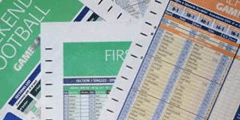Correct score betting is notoriously difficult to predict, but you should use science to get it right. Here, Frederick Steiner explains how mathematics can bring you a winning formula.
It’s 1 October 2003, and it’s Champions League night. You might recall it. It was the night that Manchester United travelled to Stuttgart, while Chelsea entertained Besiktas at Stamford Bridge. Both of the British teams were favourites to win, but it turned out to be another of those nights when commentators reach for their clichés about how unpredictable football is and how its unpredictability is what makes it so great.
To some extent they’re right. Who would have predicted that United would lose 2-1 and Chelsea would go down 2-0 at home? Certainly not the expert pundits, or most punters at the bookies. But I backed both scores correctly: the first at 16/1 and the second at an immensely satisfying 109/1. A week earlier I’d also plumped for Arsenal to beat Newcastle 3-2 at 33/1 (they did), and my mood was further enhanced when Fulham triumphed 2-0 at Blackburn. I’d backed that at 49/1, so as you can imagine, I was flying.
Was this a fluke, or do I have some kind of secret to predicting scores? The answer is neither, or both, depending on how you look at it. I do know how to make correct score betting profitable over the long run, but if you’re after some kind of secret formula that predicts the score of each result, then you’re a dreamer.
The Mug Punter
A childhood friend of mine is bright, excellent company and successful. Yet his most striking feature is that he’s a terrible gambler. He’s perhaps the worst I’ve ever seen. If he were new to betting, or perhaps suffering from some type of emotional disorder, his woeful punting would be understandable. But he is, by clinical definitions at least, sane.
My friend will always back his first hunch, which is usually devoid of rational thought. It’s based on what he thinks or, more frequently, feels is going to happen, and sometimes it pays huge dividends. Overall though, like every punter who bets on hunches, he loses money. Boring concepts such as mathematics are conspiring against him, which is why I adopt a different approach.
‘You’re such a smart-arse,’ he moans at me. ‘You’re basically just a boring maths geek. But you win. It’s so annoying.’
For once my friend is right. Successful gambling is about crunching numbers. It’s about playing the odds. It’s about putting in hours of work and winning. My friend probably has more fun, but he pays for it. I bet on outcomes when I’ve calculated that the odds are in my favour. For example, if I work out that the probability of a 1-0 home win is 12 per cent – the real odds should be around 7/1 ((1_0.12) – 1 = 7.3) – I’ll have a punt if I can get at least 8/1. In betting terms, that means that if I bet £1 on that game 100 times, I’ll win on 12 of them and lose 88. At 8/1, I make a profit of £8 (£12 x 8 – £88 = £8). At 7/1 I lose £4 (12 x £7 – £88 = -£4), yet on both occasions I’ve backed 12 winners.
That’s the first lesson anyone who wants to make money out of correct score betting has to learn. Betting when the odds are in your favour will yield profits in the long run. It’s simply the reverse of what the bookmakers usually do. The skill is playing only when you know you have the advantage. If you keep backing when the prices are in your favour, you’ll get the odd break and should profit in the long run. That’s just mathematics, which is why the approach works, but it needs patience.
The point is that you’re not trying to guess the result. Sometimes you’ll back a team you think is going to lose (just as I did with Besiktas), which seems counter-intuitive. You’ll also back a hell of a lot of losers, but you probably already do anyway. My friend thinks my method is insane. In fact, it’s incredibly sane, but boring.
So how do you know when the odds are in your favour? The first thing to remember is that they usually won’t be. You may think that the 9/1 on Bolton to beat Aston Villa 1-0 at Villa Park advertised in Ladbrokes’ window looks attractive, but once you’ve crunched your numbers it probably won’t be.
At least punters have an advantage here, inasmuch as they don’t need to have a bet unless they want to. Bookies have to take bets, so you can ignore that advert and take a better price elsewhere. But how can you be sure that the best price is a good bet? To work this out, some pretty heavy number crunching is required. Most gamblers, even serious ones, won’t want the hassle of applying this theory each week. I’ve provided some reference on the Inside Edge site (see Charts 1 and 2), which you can use as cheat sheets to give you a guide about when to bet. But to understand the theory, I recommend you read on.
The Maths Lesson
Cast your mind back to your schooldays and you might recall learning about the Poisson distribution during maths classes. If your memory is really good, you might even remember that the Poisson distribution is a good way of modelling situations with a number of independent random events occurring in a given time or place. Certain conditions are needed for the Poisson to be applicable. The variable can’t be a negative or a fraction; the events should be separate and independent of each other; they should be equally likely to occur in each period; and the random events should also be rare. If you haven’t dropped off yet, you’ll have noticed that this description applies to goals during a football match. Goals (events) occur randomly and rarely within a 90-minute period. So, for example, if you’re interested in betting on the number of goals in a game and you know that the mean number of goals per game is two, then the Poisson distribution will provide a very close fit and allow you to calculate the probabilities of different scores. If, on the other hand, you were betting on a basketball game, where scoring is more frequent, the Poisson distribution wouldn’t be applicable.
In the simplest terms, if you know that, on average, a team scores 1.2 goals per game, the Poisson says that the same team has a 30 per cent chance of not scoring in a given game (see Chart 1). There are tables of similar Poisson probabilities in the appendices of your old maths textbooks (if you can be bothered to dig them out), but I wouldn’t recommend using them. Using an Excel spreadsheet is much easier to do these calculations. It has a Poisson function built in and is very easy to set up. Just read the manual, feed in the mean goals for each team and let the computer
do the work.
Applying the Theory
If you’re rejoining us after bunking off the maths lesson, the important thing you’ve missed is that the probability of a team scoring any number of goals during a match can be calculated, providing you know what the mean (average) number of goals is.
The easiest way to calculate the average is to divide the number of goals a team has scored (let’s say, this season) by the number of games it has played. While this approach is better than simply guessing that tonight’s game is going to finish 2-1, I recommend you use a more accurate approach, taking into account the relative strengths of each side. The best bit here is that you don’t have to work any of this out for yourself, as all spread betting companies will have done the hard work for you. They publish spreads on supremacy and total goals for most top football matches and they (usually) know what they’re talking about. So if total goals are quoted at 2 and supremacy is 0.4, your average goals are 1.2 and 0.8.
The maths geeks can feed these figures into their spreadsheets, while the rest of you can easily use the table in Chart 1. The spreadsheet model will be more accurate, but if you aren’t prepared to put in the graft you can’t expect the same returns. Let’s assume that you’ve worked out that in a particular game the home team should score 1.6 goals on average, while the away team should register 1.2. Using the table you can work out the probability of each possible score.
What is the chance of the match finishing 0-0, for example? You know the probabilities on each side failing to score are 20 per cent and 30 per cent, so you simply multiply these figures together to tell you that result has a six per cent chance of happening (0.2 x 0.3 = 0.06). Similarly, a 1-1 draw has an 11.5 per cent chance of happening (0.32 x 0.36 = 0.115), while there’s a 7.8 per cent chance of a 2-0 home win (0.26 x 0.3 = 0.078). The striking thing about these calculations is they show how unlikely you are to actually pick the correct score. A 2-0 home win would hardly class as a shock result, yet you’re only going to get that one right 7.8 per cent of the time. That’s why bookies make money. You think there’s a greater chance of something happening than there actually is and you bet on it. Well now you won’t.
Beating the Bookie
So how can you actually use these numbers to make money? The bookies know everything I’ve just told you (and more) and I’ve already mentioned that their prices are rarely good value. So what’s the point?
Firstly, bookies do occasionally offer odds that should be taken. They offer prices (that is, they need to attract or discourage business for a particular bet) and they don’t always follow probabilities. For example, the 33/1 on Arsenal’s 3-2 victory over Newcastle, which I mentioned at the beginning of this piece, was placed with Coral. I enjoyed that one, chiefly because that type of opportunity is rare.
For the most part there are better prices on the online exchanges, where you’ll usually be able to find plenty of value correct score bets, or you can post your own odds. Let’s go back to the example of the 2-0 home win using the table, but this time using the digital odds preferred by the exchanges. (Digital odds are essentially the decimal version of traditional odds, only you add one to the result. So even money is 2 and 7/2 is 4.5).
As you’ve seen, the probability of the 2-0 score actually happening is 7.8 per cent, which means you’ll want digital odds of 13 (to convert, you divide 1 by the probability, so 0.078 = 12.82). You’ll then need to add a margin to give you a profit and also to account for any errors in your calculations (it’s not an exact science). It’s up to you how much you add, but remember that the higher the margin, the fewer bets you’ll find. I recommend you start by adding about ten per cent and see how you go. In this case, you’ll not bet on a 2-0 home win unless you can get digital odds of 14.1 (12.82 x 1.1) or better.
If you’ve followed all of this, you’ll have worked out that you’re going to lose on more correct score bets than you win. That’s fine, because if you get your sums right, you’ll bag some of those huge winners I tempted you with at the beginning. Those wins should give you a profit in the long run, but correct score betting is incredibly volatile. Chart 2 shows how much of a roller coaster ride it is, as it details my profit and loss in terms of points (a 5-1 win = five points) over a 38-week period. You can see how you have fantastic weeks where you look like a genius, sandwiched in between plenty of costly weeks. Just console yourself that in the long run you’ll come out on top – providing you’ve got your sums right.












